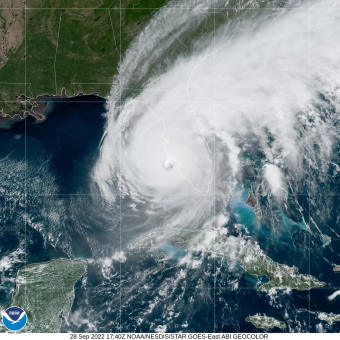- New research shows a 40% rise in hurricane rainfall rate over land for a 1°C rise in tropical Atlantic Ocean temperatures.
- In recent years, there have been increasing losses from freshwater flooding associated with United States landfalling hurricanes.
- The study is set to improve hurricane forecasts vital for vulnerable areas that suffer costly flood related damages.
New research from the National Oceanography Centre (NOC) and Maynooth University in Ireland shows a 40% rise in hurricane rainfall rate and a 140% increase in total annual rainfall over land for a one-degree rise in ocean temperatures in the North Atlantic.
The study, published in the peer-reviewed scientific journal Environmental Research Communications, provides an analysis of how hurricane rainfall rate and total annual rainfall change for a 1°C rise in ocean temperatures in the main hurricane development region of the North Atlantic, during the study period 1998–2017.
In recent years, there have been increasing losses from freshwater flooding associated with United States landfalling hurricanes. Hurricanes produce intense rainfall which causes flash flooding, and this study looks at the impact across 9 US States. In 2017 Hurricane Harvey caused more than $100bn of mostly flood related damages in the US. In 2022 Hurricane Ian caused flood losses estimated at between $8-18bn of which, around 50% are uninsured.
The study was led by Dr Samantha Hallam from Maynooth University, whilst she was a PhD student at the National Oceanography Centre. Dr Hallam said: “In this study we found a 40% rise in tropical cyclone rainfall rate and 140% increase in total annual rainfall over land when ocean temperatures are 1°C warmer than normal in the main hurricane development region in the North Atlantic, between 1998–2017.
“The 40% rise in tropical cyclone rainfall rate over land contrasts with the 6% increase in the rainfall rate observed over the Atlantic Ocean and appears to indicate a thermos-dynamic and a dynamic response anomalously warm ocean temperatures, meaning hurricanes are making landfall with higher windspeeds when ocean temperatures are warmer.”
The 140% increase in total annual rainfall, for a 1°C rise in ocean temperatures, is not only linked to the thermodynamic response associated with the Clausius-Clapeyron relationship (which says that rainfall intensity increases by about 7% for each degree of warming), but to the increase in windspeed and number of landfalling tracks which also rises with warmer ocean temperatures as highlighted in the study.
Dr Joel Hirschi, Associate Head of Marine Systems Modelling at NOC, and a senior author on the study said: “Through this study, we’re confident that the connection between ocean temperatures and rainfall will help improve hurricane forecasts, which will prove a vital resource for vulnerable areas that suffer costly flood related damages during intense hurricane seasons.”
Overall, this research provides useful insights for seasonal to decadal flood prediction from Atlantic tropical cyclones (hurricanes) and the associated flood risk, helpful for homeowners, policy makers and insurers.
These findings are the result of a statistical analysis of IBTrACS and TRMM datasets. The research was supported by the Marine Institute and funded by the Irish Government under the JPI Climate and JPI Ocean joint call and the Natural Environmental Research Council and involved collaboration between ICARUS Climate Research Centre at Maynooth University in Ireland, National Oceanography Centre, UK, University of Southampton, and University of Reading.

